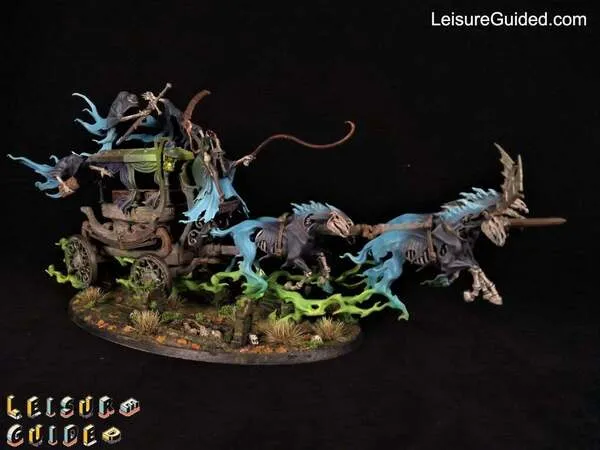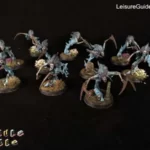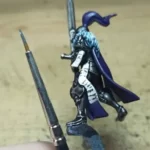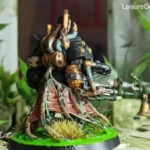how hard is it to paint miniatures (The answer is here)

Miniature painting is an art. However, if you’ve never done anything involving painting and flopped on your first try, the process might seem difficult.
Some entry-level mini painters view their first painted miniature as not really terrible but obviously not brilliant. These feelings may even cause you to discontinue painting your minis.
So, the question is, is painting miniature really that hard?
Is it difficult to paint miniatures?
If you’re a beginner painter, this is a valid question.
Painting miniatures can be both easy and hard. When you first start with this hobby you get bad results and you will struggle to get better. As you practice and improve your skills, painting miniatures will get much easier and more fun.
Like everything that involves learning, miniature painting can be hard at the beginning because the results will mostly look bad, and there are a lot of techniques to master. When you take your time with this hobby and ease into the process you will see your learning curve getting steep.
Miniature painting is hard especially when you just start because you need to learn how to hold the brush, you’ll need to learn all the different stages in the process (remove mold lines, assemble and glue the miniature, priming, painting, washing, highlighting, varnish, Etc.). As you get better in each of these techniques you will feel much more comfortable painting miniatures and your results will get better as you practice.
The good thing with miniature painting is that you will always find informative resources like tutorials and instruction books to help make the process easy, and there is also a supportive community of mini painters that will happily help you improve and answer all your questions.
The skills beginners need to develop to become better painters
Entry-level miniature paintings need to learn how to make their hands comfortable holding a brush.
Besides this, beginner painters also need to learn how to thin their paint, improve color blending techniques, shading, highlighting skills, base coating, and varnish the miniature.
As a beginner, you won’t know how to use an airbrush. So, the first thing you need to focus on is developing your brush painting skills.
Hand-brush coordination is integral when brush painting your minis. If your hands and brush are not in sync, you will only get less satisfactory results than you desired.
On the other hand, how well your painting session turns out will depend on how properly thinned the paint is, the color blending, shading, highlighting, base coating, and vanishing technique you use. Without these skills, you can’t paint a fully assembled model.
How long will it take to master miniature painting
How long it will take to master miniature painting differ for every person.
However, it will take you a couple of years to experiment with different miniatures daily to develop your skills.
For one, many people have been painting minis for 20 years and are still learning. But, that doesn’t mean their skill level is intermediate.
It took me one week to learn hand-brush coordination, 2 years to find my creative artsy side, 3 hours daily on a miniature, finish 2 small tabletop figures in a week, and 5 years to fully master miniature painting basics.
The hard parts of miniatures painting
Some people find miniature painting difficult due to the technique required, expectations on the finish, and color mixing to get consistent results and motivation.
- Techniques: As mentioned earlier, miniature painting techniques are surplus. There is airbrushing, dry brushing, color blending, shading, and zenithal technique. It would be easy if each technique employs the same method. However, for every technique, you need to learn them differently.
- Consistency: thinning paints to get the right milk consistency can also be difficult. Yes, you may know the right thinning ratio to use. Yet, the viscosity and opacity of the paint may affect will determine how well it thins.
- Motivation: miniature painting is time-consuming and if you are not careful may make you feel frustrated and give up, especially when painting a large figure.
- Level of Results: most times, your level of expectations won’t give desired results. You may always face a potential limitation when painting your minis, making it hard to get good results.
Understand that even experienced painters face these difficulties, although not as much as beginner painters. Don’t let the process get to you. Rather, have fun and find what works for you.
Get better at painting miniatures
- Practice makes perfect
Thinking about where to start isn’t going to help you develop your painting skills. You will only get better at painting your minis if your hand, body, and mind are in sync, and the best way to achieve this is through consistent practice.
The bottom line, the results from your first try don’t really matter. What matters is how often you paint after a failed first try. So, continue painting to learn to paint minis.
- Get good tools
Whether it is the simplest of tools like a towel, you should use quality tools.
Believe it or not, cheaping out on paint gears will hinder your skills, speed, and result.
Cheap paints and brushes will always make you feel frustrated as you continue on a failed track. So, invest in good tools so that it doesn’t get in your way of getting better at painting miniatures.
- Watch\read tutorials
Besides investing in good paint tools, another way to get better at painting miniatures is to watch painting tutorials, or read instructional books.
Try as much as you may, but as an entry-level painter, you won’t really know where to start painting. Experience goes a long way in making your work seamless, and since you don’t have it, tutorials will show you how.
Other tips to make painting miniatures easier
While the three tips above are essential in getting you to a pro-level painter, they aren’t enough. Some other things you need to keep in mind are:
- Ask questions. Experienced painters use different styles and techniques you don’t know.
Get involved in a community to get more information and help. - Get creative. When it involves creativity, no one will fault you for trying something new. Just remember that you don’t have to use the same approach or style as someone else. An advantage of miniature painting is that you are free to express yourself with colors.
- Move out of your comfort zone. As you practice, your skills improve. However, sticking to one formula or technique can hinder further development. Try something new or experiment with every chance you get.
Which miniature painting tutorials should you watch and read
There are tons of miniature painting tutorials online to help you learn how to paint miniatures.
To learn the wet blending technique, check out Miniac’s “how to wet blend” tutorial on YouTube and learn simple wet blending tips for your small minis.
Tabletop Minions “how to dry brush minis: trips and tricks” on YouTube will teach you how to dry brush.
Painting miniatures can be relaxing, and only hard at the beginning
Painting miniatures is easy but can also be difficult, depending on how much time and effort you put into it. Just enjoy the process.
When you paint for the fun of it, you find yourself relaxed no matter how stressful your day may seem. Remember that it is not something you can get right on the first try but with time, you will find your skills improving.
The easiest technique to use as a beginner and make your paint job easier
The easiest technique to use as a beginner is dry brushing.
It involves loading your paintbrush with paint and removing excesses by brushing it on a towel before painting the miniature kit.
The technique does not take long to learn. Then again, the keyword here still is “beginner.” You won’t magically know how to use this technique without practice.
Other techniques for miniature painting
Are they difficult?
Airbrushing and blending are other techniques often used in painting miniatures. But, these techniques are quite difficult to master.
Airbrushing may seem quite easy, thanks to its mechanical input. However, it can be hard to use due to the spray application involved with using an airbrush. On the other hand, blending is a master-level technique and can be challenging since it involves mixing colors on the miniature.





